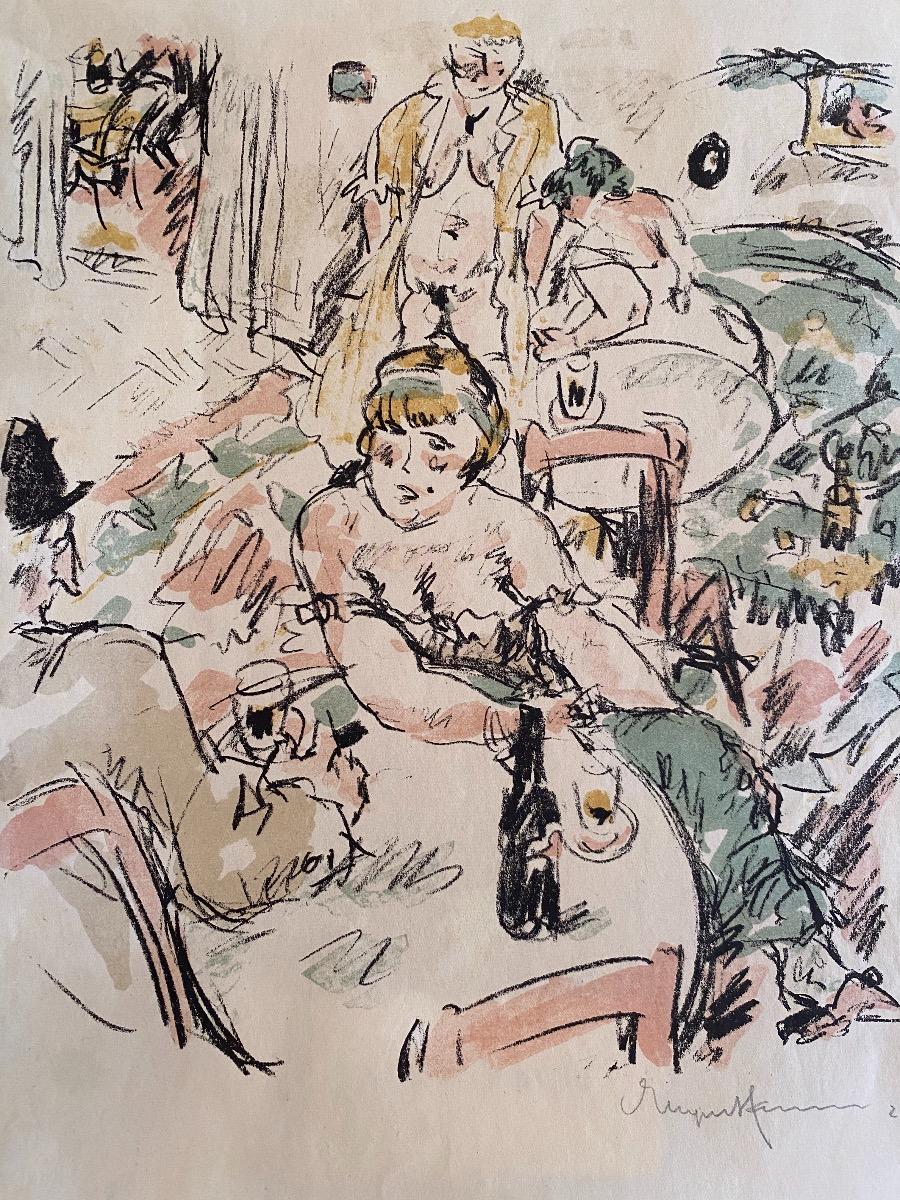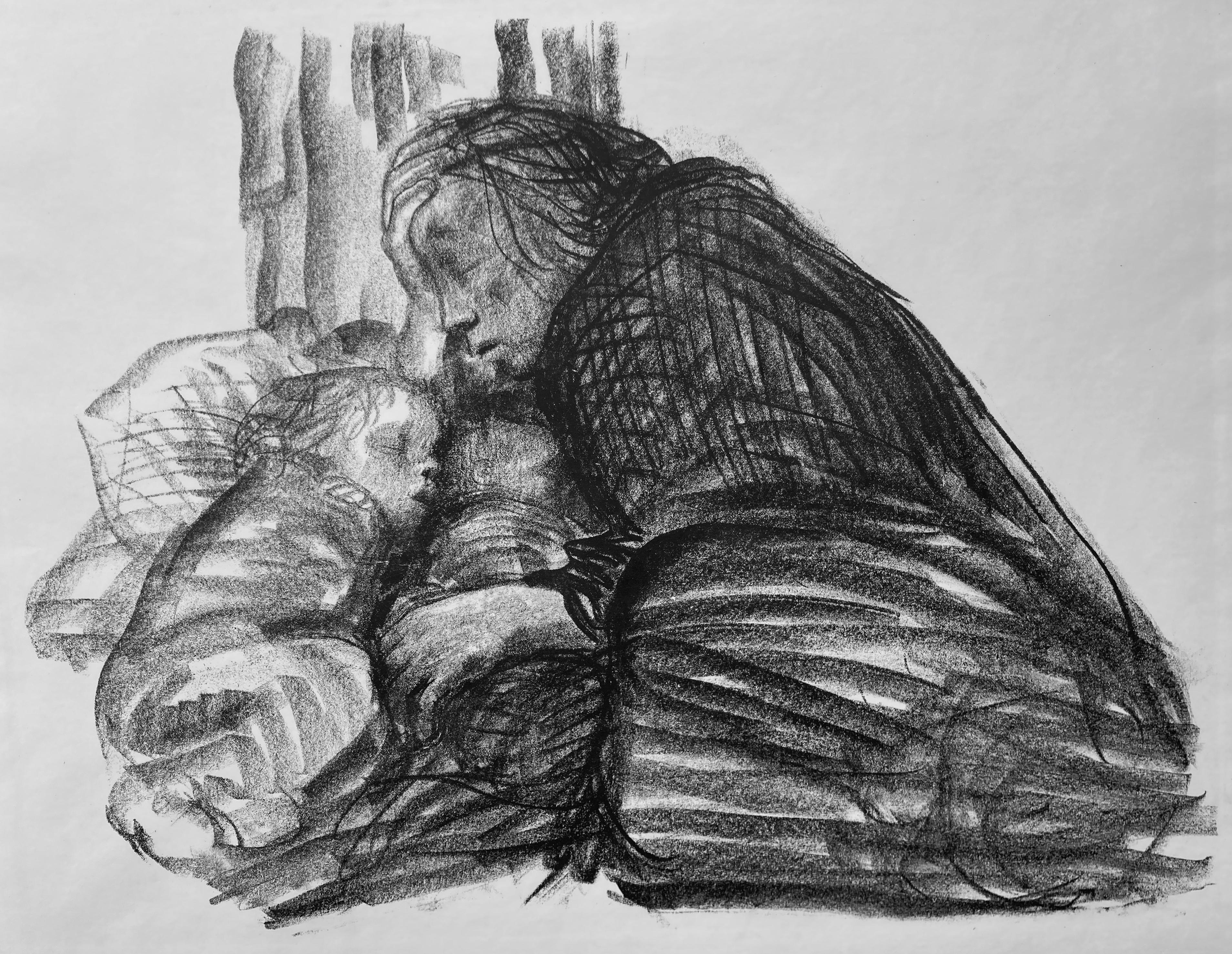Items Similar to Kostume, Plakate, und Dekorationen, "Schlange (Snake)"
Want more images or videos?
Request additional images or videos from the seller
1 of 3
Walter SchnackenbergKostume, Plakate, und Dekorationen, "Schlange (Snake)"1920
1920
About the Item
Walter Schnackenberg’s style changed several times during his long and successful career. Having studied in Munich, the artist traveled often to Paris where he fell under the spell of the Henri de Toulouse-Lautrec’s colorful and sensuous posters depicting theatrical and decadent subjects. Schnackenberg became a regular contributor of similar compositions to the German magazines Jugend and Simplicissimus before devoting himself to the design of stage scenery and costumes. In the artist’s theatrical work, his mastery of form, ornamentation, and Orientalism became increasingly evident. He excelled at combining fluid Art Nouveau outlines, with spiky Expressionist passages, and the postures and patterns of the mysterious East.
In his later years, Schnackenberg explored the unconscious, using surreal subject matter and paler colors that plainly portrayed dreams and visions, some imbued with political connotations. His drawings, illustrations, folio prints, and posters are highly sought today for their exceedingly imaginative qualities, enchanting subject matter, and arresting use of color.
SCHNACKENBERG: KOSTUME, PLAKATE UND DEKORATIONEN, a cardboard bound art book consisting of 43 prints of work by Walter Schnackenberg, 30 of which are color lithographs that are signed and some are titled and dated in the plate, as well as black and white prints and photographs with accompanying text by Oskar Bie; lithographs printed at Kunstanstalt Oskar Consee in Munich, other images printed by Gesellschaft Pick & Co. in Munich, the text and cover with color images by Schnackenberg front and verso printed by R. Oldenbourg in Munich; published by Musarion Verlag, Munich, 1920.
The majority of Walter Schnackenberg’s artistic output was destroyed by bomb attacks in Munich in 1944. The highly publicized 2013 auction in New York of the recovered pre-war poster collection once belonging to German poster aficionado, Hans Sachs has reintroduced the world to Walter Schnackenberg’s graphic genius and priceless ephemeral art from a lost era. Besides the museum world, designer Karl Lagerfeld is one of the most prodigious collectors of Schnackenberg. Flipping through the pages of Kostume, Plakate und Dekorationen, it becomes quite clear that Schnackenberg’s collection is ground zero at the crossroads of early modern fashion where the cult of celebrity meets up with dance, music, theater and cabaret, film and the graphic medium. Berlin and Munich under Germany’s Weimar Republic in the first quarter of the 20th century produced just the atmosphere to feed this burgeoning industry. Rising inflation sparked a recklessness to live large for the moment and heightened a desire for escapism. An influx of Indian and East Asian dancers and musicians added to the artsy bohemian cultural mix. A new decadence and tolerance resulted. Film boldly featured provocative subject matter. Cabarets became popular venues giving rise to the demi-monde in which people from all social stations mixed more freely in a thriving underground economy and culture where there was a blurring of boundaries and of social codes. Noted art historian and cultural doyen, Oskar Bie astutely observes in his introduction to Schnackenberg’s publication that what unites the images is fantasy and advertisement. Schnackenberg uses the eye as an instrument to brilliantly construct and convey this double message. His personages never directly confront the viewer. Their eyes gaze off in the distance like those of the screenplayer and film star Hedamaria Scholz in Schnackenberg’s “Die Rodelhexe” movie poster. Their eyes follow the path of a dance composition or become a transfixed and ogling male gaze such as the iconic 1911 Odeon Casino poster. Most of all, their eyes are heavily-lidded and closed unto themselves, to an inner state, a dream, an escape, a fantasy. Whether it is to pass an hour in a cinema, an evening at a cabaret, to attend a modern dance performance or patronize a glitzy club, fantasy is what really is being sold. It is interesting to consider that all of this is sandwiched in between two commercial subjects which is essentially the bread and butter of Schnackenberg’s art book. On the first page, Schnackenberg, the artist, advertises himself. While the female face which he is shown creating takes on a double image with its shadow, suggesting the replicative nature of graphic art, there is only one Schnackenberg. The final color lithograph is a poster Schnackenberg created for Consee, the printer of Kostume, Plakate und Decorationen, who also specialized in printing business materials. In the modern age, the art of business had indeed become the business of art.Kostume, Plakate, und Dekorationen, ""
- Creator:Walter Schnackenberg (1880 - 1961, German)
- Creation Year:1920
- Dimensions:Height: 13.25 in (33.66 cm)Width: 9.25 in (23.5 cm)
- Medium:
- Movement & Style:
- Period:
- Condition:
- Gallery Location:Chicago, IL
- Reference Number:1stDibs: LU46731518063

About the Seller
5.0
Platinum Seller
These expertly vetted sellers are 1stDibs' most experienced sellers and are rated highest by our customers.
Established in 2013
1stDibs seller since 2016
84 sales on 1stDibs
Typical response time: 1 hour
- ShippingRetrieving quote...Ships From: Chicago, IL
- Return PolicyA return for this item may be initiated within 3 days of delivery.
More From This SellerView All
- Gerlach's Allegorien, plate #66: "Tragedy" Lithograph, Gustav Klimt.By Gustav KlimtLocated in Chicago, ILGustav Klimt created this image for inclusion in Gerlach & Schenk’s Allegorien the year before he formed the Vienna Secession. While this design is similar to his other inclusions, L...Category
1890s Vienna Secession Figurative Prints
MaterialsLithograph
- Ottokar Mascha Folio: plate 11 "5th Secession Exhibition Poster" by Kolo MoserBy Koloman MoserLocated in Chicago, ILafter KOLOMAN MOSER (1868-1918) 5TH SECESSION EXHIBITION POSTER, 1899, (In Mascha, no. 11) A pivotal figure in early-20th century Austrian ...Category
1910s Vienna Secession Figurative Prints
MaterialsLithograph
- Gerlach's Allegorien, plate #46: "Love" Lithograph, Gustav Klimt.By Gustav KlimtLocated in Chicago, ILKlimt’s association with Martin Gerlach dates back to the early 1880s when Gerlach and Schenk published their first edition of Allegorien und Embleme. By the mid-1890s, they were pla...Category
1890s Vienna Secession Figurative Prints
MaterialsLithograph
- Sema portfolio, 1912, "Male Nude I" Lithograph print 21/215By Egon SchieleLocated in Chicago, ILMALE NUDE (SELF-PORTRAIT) I by Egon Schiele, 1912, a brush and ink lithograph on vellum paper made for the Munich-based artists’ association, Sema 15 Originalsteinzeichnungen portfol...Category
1910s Vienna Secession Figurative Prints
MaterialsLithograph
- Gerlach's Allegorien Plate #94: "Heads" LithographBy Koloman MoserLocated in Chicago, ILKoloman Moser (1868 –1918), AUSTRIAN Instead of applying his flair and art education solely to painting, Koloman Moser embodied the idea of Gesamt Kunstwerk (all-embracing art work) by designing architecture, furniture, jewelry, graphics, and tapestries meant to coordinate every detail of an environment. His work transcended the imitative decorative arts of earlier eras and helped to define Modernism for generations to come. Moser achieved a remarkable balance between intellectual structure (often geometric) and hedonistic luxury. Collaborating with Gustav Klimt and Josef Hoffmann, the artist was an editor and active contributor to Ver Sacrum, (Sacred Spring), the journal of the Viennese Secession that was so prized for its aesthetics and high quality production that it was considered a work of art. The magazine featured drawings and designs in the Jugendstil style (Youth) along with literary contributions from distinguished writers from across Europe. It quickly disseminated both the spirit and the style of the Secession. In 1903 Moser and Hoffmann founded and led the Wiener Werkstatte (Viennese Workshop) a collective of artisans that produced elegant decorative arts items, not as industrial prototypes but for the purpose of sale to the public. The plan, as idealistic then as now, was to elevate the lives of consumers by means of beautiful and useful interior surroundings. Moser’s influence has endured throughout the century. His design sensibility is evident from the mid-century modern furniture of the 1950s and ‘60s to the psychedelic rock posters...Category
1890s Vienna Secession Figurative Prints
MaterialsLithograph
- Gerlach's Allegorien Plate #98: "Poetry" Lithograph by Carl Otto CzeschkaBy Carl Otto CzeschkaLocated in Chicago, ILafter Carl Otto Czeschka, (1878-1960), Austrian A leading member of the Vienna Secession and later the Wiener Werkstätte (Viennese Workshop), Carl Otto Czeschka was a vital figu...Category
1890s Vienna Secession Figurative Prints
MaterialsLithograph
You May Also Like
- In the Brothel - Original Lithograph by Eugen Hamm - 1922Located in Roma, ITIn the Brothel is an original lithograph realized by Eugen Hamm in 1922. In good conditions. This artwork represents a brothel with several nude women. H...Category
1920s Expressionist Figurative Prints
MaterialsLithograph
- STADTISCHES OBDACH (Urban Shelter)By Käthe KollwitzLocated in Santa Monica, CAKATHE KOLLWITZ (German 1867 -1945) STADTISCHES OBDACH (Urban Shelter) 1926 (Knesebeck 226, Klipstein 219.bB), Lithograph from the unsigned edition for the annual edition of the Kuns...Category
1920s Expressionist Figurative Prints
MaterialsLithograph
- Iron CrossBy Rufino TamayoLocated in San Francisco, CAArtist: Rufino Tamayo Title: Iron Cross Year: 1988 Medium: Color lithograph Edition: Numbered CCXLV/CCC in pencil Paper: Wove Image size: 22.5 x 30...Category
1980s Expressionist Figurative Prints
MaterialsLithograph
- Francisco Zuniga, "El Rebozo Blanco, " original lithograph, hand signedBy Francisco ZúñigaLocated in Chatsworth, CAThis piece is an original lithograph done by Francisco Zúñiga in 1986. Francisco Zúñiga was a Costa Rican-born Mexican artist best known for his stylized figurative paintings and scu...Category
1980s Expressionist Figurative Prints
MaterialsLithograph
- Naomie aux Longues TressesBy Théo TobiasseLocated in San Francisco, CAArtist: Teo Tobiasse (French/Israeli, 1927-2012) Title: "Naomie Aux Longues Tresses" Year: Circa 1970 Medium: Color lithograph Edition: Numbered 146/150 in pencil Paper: Japan...Category
Mid-20th Century Expressionist Figurative Prints
MaterialsLithograph
- Steet Vendor with Little GirlBy Jean JansemLocated in San Francisco, CAArtist: Jean Jansem (French/Armenian, 1920-2013) Title: Street Vendor with Little Girl Year: c. 1960 Medium: Color lithograph Edition: Numbered 144/200 in pencil Paper: Arches p...Category
Mid-20th Century Expressionist Figurative Prints
MaterialsLithograph

